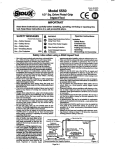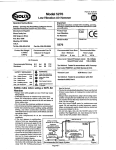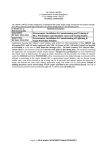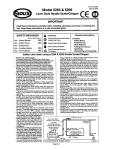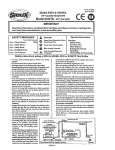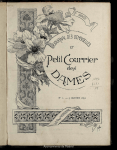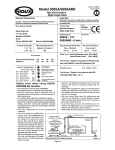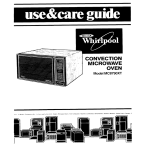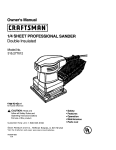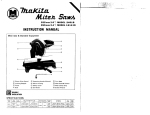Download Sioux Tools 5040 User's Manual
Transcript
- Form # Z397 Date 11-97lA Model 5040 @Câ@ 318'' Sq. Drive Butterfly Lever Impact Wrench IMPORTANT Read these instructions carefully before installing, operating, servicing or repairing this tool. Keep these instructions in a safe accessible place. 2 1A SAFETY MESSAGES Use Use - Safety Gloves - Safety Boots - BreathingMasks Use - Ear Protectors Use YES 1 WARNING @ Always Wear Safety Goggles @ ~arliearing Protection , & I Avoid Pmhged Exposure To Vibration Operator Instructions ~ o r e & e nUse Work Stations Putting Into Service Operating Dismantling and Assembly. Safety rules when using a 5040 Impact Wrench - Use oniy impactsockets and extensions, universaljoints, etc., ratedas baingsuitable for use with impactwrenches. - Prolonged e-ure to vibration may cause injury. - Take care that the exhaust air does not point towards any - Do not exceed the maximum working air pressure. - Use personalprotectionequipment & r&mended. -- UIf thes tool e - d r m & W w m appears to malfunction, remove from use - - - -b R d A i m b a b W W W - N *Mhbmd6dm** requirementswhen installing, usingor maintainingthe tool. m m d other person or material or substance that could be contaminatedby oil droplets. When first lubricating a tool or if the tool exhaust has a high oil content, do not allow the exhaust air to come near very hot surfaces or flames. Never lay the tool down until the working attachment has stopped moving. When the t d is not in use,shut off the air supply and press throttle triggerhever to drain the supply line. If the t d is not to be used for a period of time, first lubricate, disconnectfrom air supply and store in a dry average room temperature envirmnt. If the t d is passed from one user to a new or inexperienced user, make sure these instructionsare availableto be passed with the t d . Do not remove any manufacturer fitted safety devices where fitted, i.e., wheel guards, safety trigger, speed governors, etc. Wherever possible, secure workpiece with damps, a vise, etc. to make it rigid .so it does not move during the work operation. Keep good balance at all times. Do not stretch or overreach. Try to match the t d to the work operation. Do not use a tool !hat is too light or heavy for the work operation. If in doubt, seek advice. In general terms, this tool is not suitable for underwater use or use in explosiveenvironments seek advice from manufacturer. Try to make sure that the work area is dear to enable the work task to be performed safely, If practical and possible, try to dear unnecessary obstructions before starting work. h a y s use air hose and couplings with minimum working pressure ratings at least 1 1/2 times the maximum working pressure rating of the tool. immediatelyand arrange for s e w atxi repair. If it is not practical to remove t d from service, then shutoff the air supply to the t d and write or have written a warning note and attach it to the tool. If tool is to be used with a balancer or other suspension device, ensure that the tool is firmly attached to the suspension/support device. - When operating the tool, always keep the body and particularly the hands away from the working attachment fixed to the t d . The tool is not electrically insulated. Never use the tool if there is any chance of coming into contact with live electricity. Always when using the t d , adopt a firm footing and/or position and grip the tool sufficiently only to overcome any reaction forces that may result from the t d doing work. Do not overgrb. - Use only correct $are parts for maintenanceand rew'r. Do not improvise or make temporary repairs. Maior servicing and repairs should only be cahed out -by wrsons trained to do soDo not lock, tape, wire, etc. the 'On/0ff' valve in 'On' position.The throttle triggerhever, etc. must always be free to return to the 'Off' position when released. Awa shut off the air supply to the tool and press the '0n/&' valve to exhaust the air from the feed hose before fitting, removing or adjusting the woking attachment fitted to the t d . Eefore usingthe tool, make sure that a shut off device has been fitted to the Ail P i And F i l t i i supply line and the position is known and easily accessible so that the air supply to the t d can be shutoff in an *W emergency. wiul s u w i capacity C h e C k ~ a n d ~ r e g ~ f G f T~o Maintain . U m W ~ & ecare against entang~ementof the - - - - - - - - - - - - - 1 Low Spot To L.2 -I Trap Water Easy To Reach And nmingpartsofthetcdwihdothing,hair, - Take Air From Top Air T d m ,% yw % 9-am r l=+c* b~ts,etc.Tlnscuddcause~body orpartsofthcJbodytobedmwntuwa~~~ a n d i n ~ ~ t h e ~ ~ o f t h c J todandcculdbewty~ It is expectedthat users will adopt sfe working practices and observe all local, regional or country legal RecommendedAir Supply System 1 Page No 1 Figure 1 Foreseen Use Of The Tool - 5040 The impact wrench is designed for the tightening and I m n i n g of threaded fastener within the range as specified by the manufacturer. It should only be usedin conjunction with suitable impact type 3W square female drive nut running sockets. Only use sockets w h i i are of the impact type. It is allwed to use suitable extension bars, universal joints and socket adaptors b e W n the square output drive of the ratchet wrench and the female square drive of the socket. Do not use the tool for any other purpose than that sptxified without consulting the manufacturer or the manufacturet's authorized supplier. To do $0 may be dangemus. Never use an impact wrench as a hammer to dislodge or straighten cmss threaded fasteners. Never attempt to modify the tool for other uses and never modify the t d for even its recommended use as a nutrunner. Work Stations The tool shoutd only be used as a handheld, handoperated tool. lt is always recommendedthat the tool is usedwhen stadng on a solid floor. It can be used in other positions, but before any such use, the operator must be in a secure position having a firm grip and footing and be aware that when loosening fasteners the t d can m e quite quickly away from the fastener being undone. An allowance must always be made for this rearward movementso as to avoid the possibility of hand'amhdy entrapment. Putting Into Service Air Supply Use a clean iubtkatedair supply that will give a measuredair pressure at the tool of !XI PSIG (6.2 bar) when the tool is runningwith the tri~erflW8rfully depressed. Use recammendedhose Size and lenath. It is recommended that the tool is connected to the air supply as s & m in figure 1. Do not connect the tool to the air line system withzut incorporating an easy to reach and operate air shut off valve.-he air supply should be lubricated. It is strongly recommendedthat an air filter, regulator, lubricator (FRL)is us& as shown In Figure I as thii will supply clean, lubricatedair at the correct pressure to the tool. Details of such equipment can be obtained from your supplier. If such equipment is not used, then the tool shouklbe lubricatedby shuttingoff the air supply to the t d , depressurizingthe line by pressing the trigger on the t d . D i i n n e c t the air line and pour into the hose adaptor a teaspoonful (5ml) of a suitable pneumatic motor lubricating oil preferably incorporating a rust inhibiior. Reconnect tool to air supply and run t d slowly for a few seconds to albw air to circulate the oil. If tool is used freauentlv. lubricate on daii basis and if tool starts to slow or lose mwer. It is recommended that Wnt tight& &the threaded fasiener assembly be checked with a torque wrench. It is recommended that the air pressure at the tool while the tool is tunning is 90 PSU6.2 bar. Operating The output of the impact wrench in prime working condition is governed by mainly three factors: a) the input air pressure; b) the time the impact wrench is operated on the jomt. Normai time for joints of average tension requirement 3 to 5 seconds; c) the setting of the air regulator for a g h n joint at a given pressure operated for a given time. The air regulator (47) can be used to regulate the output of the impact wrench if no other means of control is available. It is strongly recommended that an external pressure regulator, ideally as parlof a filterlregulatorflubricator(FRL), is usedto control air inlet pressure so that the pressure can be set to help control the tension requid to be applied to the threaded fastener joint. There is no consistent, reliable toque adjustment on an impact wrench of this type. However, the air regulator can be used to adjust tomue to the awmximate tiahtness of a known threaded ioint. To set the tool to the desired tome. select a nut or screw of known tightness of the &me size, t6read pitch and thread condiik as those on the job.Turn air regulatoito low position, apply wrench to nut and gradually increase power (turn regulatorto admit mom air) until nut moves slightly in the direction it was originally set. The t d is now set to duplicate that tightness, note regulator setting for future use. When tightening nuts not requiringcritical toque values, run nut up flush and then tighten an addiional onequarler to onehalf turn ( & i t additional turning is necessary if gaskets are beingclamped). For additional power needed on disassembly work, turn regulator to its fully open position. This impact wrench is rated a 3/8" bolt size. Ratingmust be downgraded for spring U bolts, tie bolts, long cap screws, double depth nuts, badly rustedconditionsand spring fasteners as they absorb much of the impact power. When posdtie, clamp or wedge the bolt to prevent springback. Soak rusted nuts in penetrating oil and break rust seal before removing with impact wrench. If nut does not start to move in three to five seconds use a larger size impact wrench. Do not use impact wrench beyond rated capacity as this will drastically reduce tool liie. NOTE: Actual toque on a fastener is directly relatedto joint hardness, tool speed, conditionof socket and the time the tool is allowed to immct. use the simplest possible tool-to-socket hook up. Every connectiona b s o h energy and reduces paver. The direction of mtationof thii tool Is contmlled by the throttle lever. Be sure that it is knownw h i i side ol the lever has to be pressed to give the required direction of mtatiin before applying the impact wrench to the joint to be fastened or loosened. For best resuns: I ) Always use the correct size impact type socket. 2) Use extra deep sockets in place of extension bars where possible. 3) Do not use oversized, worn or cracked sockets. 4) Hold the wrench so the socket fits squarely on the fastener. Hold the wrench firmly, but not too tightly, pressing slightly forward. Dismantling & Assembly Instructions Disconnect tool from air supply. Pry off rubber nose guard (I) from motor housing (5). Remove oiler screw (3) and O-ring (4) and drain oil from the front end into a suitable container. Gripthe tool in a vise locatingon the square drive of the anvil (12). Unscrew 2 screws (50)and remove 2 lock washers (49) and retainerplate (48). Pull out air regulator (47) completewith O-ring (46) being careful not to lose ball (44) and spring (45).Tap pin (36) with a suitable punchas fas as possible out of the assembly, but still allow the assembly to mtate. It is now necessary to grip the length of the pin driven throughthe assembly and pull it out taking care not to deform it. LiftOffcollar (37) and pull out inlet bushing (43). O-rings (41) and (42) may be removed from the stem on inlet bushing (43). Unscrew 2 cap screws (39) and 2 cap screws (40) and remove together with 4 lock washers (38) to release bat# cap (30)and gasket (29)from the assembly. At this stage, remove throttle lever (7)together with 2 throttie Pins (6). Fmm back cap assembly pulloff 2 plungers (31) and remove 2 Springs (32) and 2 valves (33). It is then possibleto lever out 2 valve seats (34) and 2 springs (35) taking care to protectthe eyes as the springs can fly out when released. Pull out m t o r pin (22) and extract the ayembly comprisingof retaining ring (28). rear end plate (26). bearing (27), mtor (24),6 mtor blades (23) and cylinder (25). Note at this tlme the way the cylinder (25) ir removedand note that it must be reassembledin the same way with the chamfer on the outside diameter to end face at the fmnt end of the tool. Remove mtor blades (23) from mtor (24), take off retaining ring (28) and pull mtor (24) through rear end plate (26) and bearing (27) assembly. Using a suitable punch, bearing (27) may be removed from rear end plate (261, Pull out front end plate (21) complete with O-ring (20) and carefully pry off the O-ring, Remove bearing (17) and oil seal (18) from front end plate (21). Remove retaining ring (19) from motor housing (5) and take out the complete hammer mechanism. Take off O-ring (15) from cage (16) to remove hammer (14). 2 cage pins (13) andanvil (12). O-ring (10) may be levered off and O-ring ( I 1) removedfrom anvil (12). oil seal (2) may be hooked out of and anvil bushing (8) pressed out of motor housing (5). Page No 2 -- 318'' Square Drive Butterfly Lever Impact Wrench I 2 3 4 I1 1 1 1 1 1 1 I2 t 13 1 16 17 18 21 22 1 1 24 25 26 I 1 1I 1 67163 67IH 67165 67037 67172 67173 67174 67176 67177 67178 1 Houslng Cover IOlISeal 1 Plug 1 0-RIM % 1 Hammer Pin (2Y , 67190 33 67192 35 36 37 1 Rubber Rlng 1 ZW Sa. Anvil ilwudas Fh. " I 0-& 111 - 33 32 1 Plun~er(2y Piunger Spring [2y Valve Pin (21' 67191 1 1 .. W~Spdt@(2)" Rdl Pln Cdhr 67194 671n5 1 1 Hammer Cage 1 M..I Bearim ... 1 Olt Seal 1 , . 1 Front Plate 46 1 1 67181 67182 1 Motor Pin 47 1 672M 1 1 67184 1 1 1 1 67185 671W Rotor 1 Cylinder 1 Rear Plate 1 49 54 WSIWMI - 1 0-Ring Air Rmulator 67% LmkWasher (2r 67207 Screw(2)" N a m Plate ( W O ) 67384 *odor Quantityas N M ~ Page No 3 ~ ~ w / S u p SIOUXT d s Inc. 2901 Floyd BouIev&~I ~ Produd T m 3BnSq. Drive Bunerfiy i WM Lever Impact Wrench i Serial No. Model Nomos USA. Tel No. W2-2524525 Fax No. 712-2524267 ~ Use Of e M a m e r Or Support Product Net Weqht 2.2 bs 1.0 Kg R ~ NO I d Recommended Hose Bore Si- Minimum m6 Ins 8 MIM - use- b r m & o m YES - - - Noise Levek S a n d Pressure Level 87.0 dWA) * Sound Power level 98.0 dWA) Air ?-re RemmmndedWorking Maximum RecommendedMax. Hose Length WFt I O M 62 6.2 bar bar 90 W PSl PSf Test Methad: T e d 4 in -dance with P~~?urop test wde PbI8NTCl and IS0 Standard 3744 M b W n Level Less than 2.5 Meters / S& Test M e t h ~ Tested in accordance with IS0 standards 8662 Parts I & 7 1 A y=w hlaration of Conformity Sioux Tools lnc. 2901 Floyd Boulevard, P.O. Box 507, Sioux City, Iowa 51102 a r eu w our sak rwpns&irwh t nw PMUU Model 5040 Butterfly Lever Impact Wrench, Serial Number ~ g m ~ Parts I & 7, Pneurup PN8NTCl lB6WEEC ~& 9 W W E C Directives PMinJapan m





